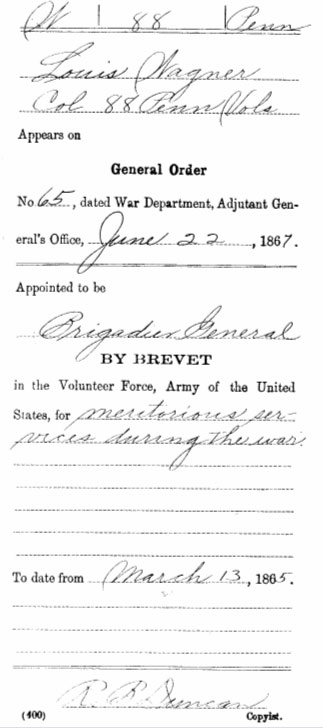Colonel Louis Wagner
Lt. Colonel Louis Wagner
Captain Louis Wagner of the 88th Pennsylvania Infantry Regiment knew that his situation was desperate when a Confederate bullet shattered his right shin at the Second Battle of Bull Run on the afternoon of August 30, 1862. The fight had been raging ferociously since noon, with Southern fire slamming relentlessly into Union soldiers commanded by Major General John Pope. That night the defeated Northern army retreated toward the safety of Washington, leaving behind some 16,000 casualties.

One of those casualties, 24-year-old Louis Wagner, would be taken prisoner by the victorious Rebels and later paroled to his Philadelphia home. The German-born Wagner, despite his youth, had been a shining star ever since he enlisted at the outbreak of the war, rising steadily in rank and prestige. By the time he was wounded at Second Bull Run, he had already fought valiantly at Cedar Mountain, Rappahannock Station, Thoroughfare Gap and Groveton.
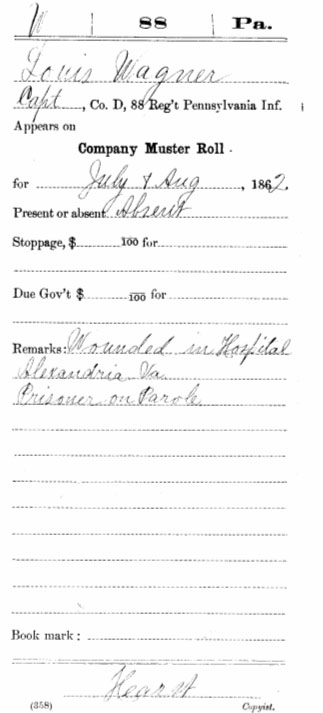 |
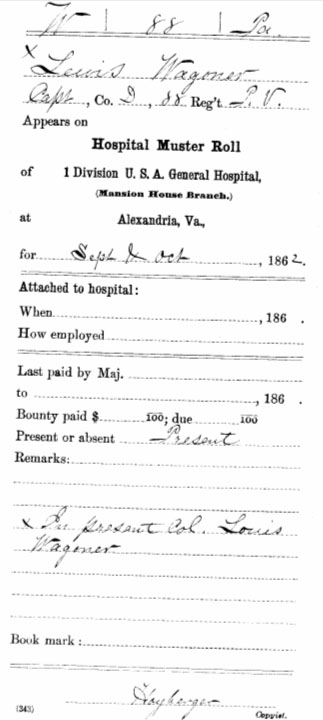 |
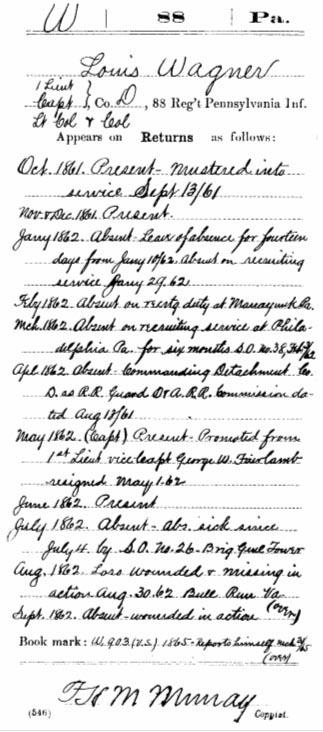
Before his wound had sufficiently healed, Wagner returned to the front in preparation for the Battle of Chancellorsville. His hasty return aggravated his wound, and Wagner returned home to Philadelphia, unfit for further field duty. The determined young officer did not return to his civilian occupation of lithographic printer. Instead, in early 1863 he volunteered to take command of Camp William Penn, the first and largest Federal training facility for African-American soldiers.
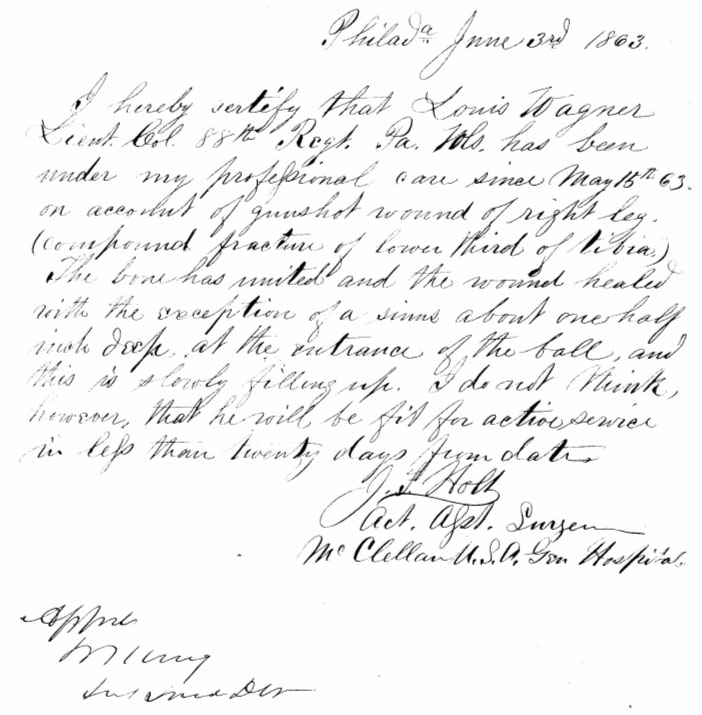
When President Abraham Lincoln’s Emancipation Proclamation freeing the slaves held in Confederate states took effect on January 1, 1863, thousands of free blacks and ex-slaves rushed to enlist in the Union Army. Many poured through the gates of Camp William Penn, about 10 miles north of downtown Philadelphia in the rolling, green Pennsylvania countryside. First Lieutenant Oliver Willcox Norton of the camp’s 8th United States Colored Troop (USCT) Regiment, formerly a private in the 83rd Pennsylvania, later described the enthusiasm of the black recruits. “Our camp thronged with visitors…who wanted to enlist,” he wrote. “There are hundreds of them, mostly slaves, here by now, anxiously waiting for the recruiting officer. The boys are singing: ‘Rally round the flag, boys, rally once again, shouting the battle cry of freedom; down with the traitor, up with the star.'”
Despite the lingering pain of his injury, Wagner took command and personally helped drill the camp’s first new recruits. Although unable at times to walk, the newly minted lieutenant colonel had himself lifted into the saddle on his horse as he readied the 3rd USCT for what he knew would be a soul-testing career in the Union Army.
Ref: http://afroamhistory.about.com/library/prm/blsoldiersinblue1.htm
As Commandant of Camp William Penn
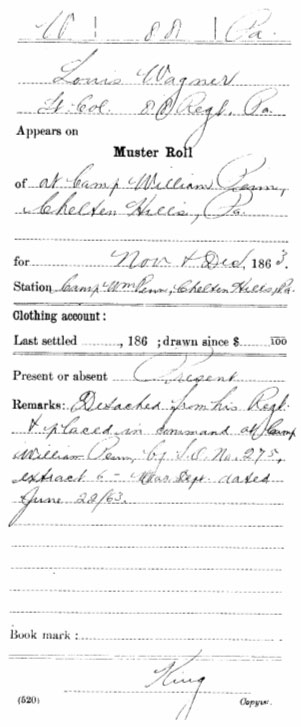
Preparing for the Close of Camp William Penn
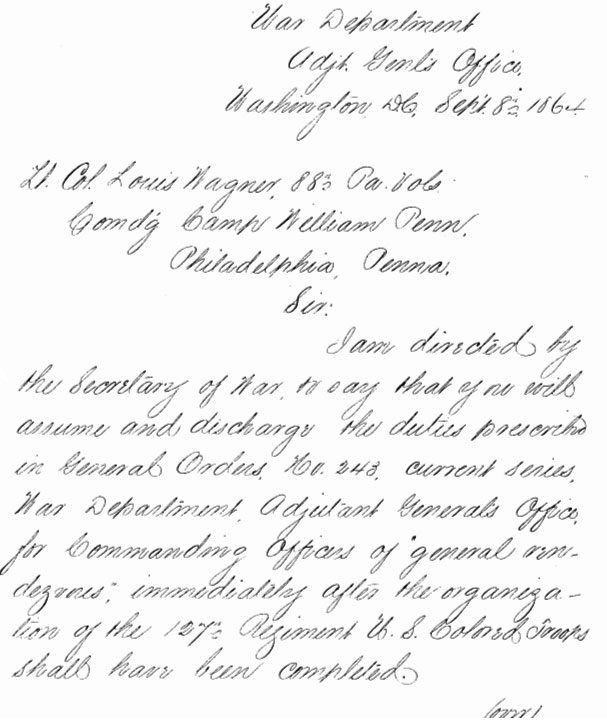
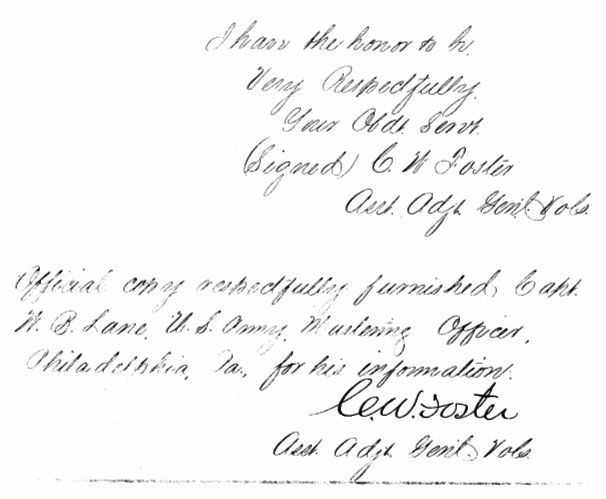
After the war, Louis had been promoted to General and took part in the 1871 funeral of Octavius Valentine Cato.
Ref. http://www.afrolumens.org/rising_free/waskie1.html
General Louis Wagner, a hero of the fighting of the Civil War, who had commanded at Camp William Penn, training facility for the eleven (11) ‘colored’ regiments of the U.S. Colored Troops that Catto had helped to recruit and organize, led the funeral procession. Wagner now commanded the 5th Brigade of the National Guard, and had served with Catto during the War. He was also a Union League member, staunch supporter of equal rights and a leading Republican politician. The procession was formed in Broad Street and marched past buildings draped in black mourning ribbon and bunting. The Union League House displayed a huge American flag bordered in black. The parade consisted of regiments of the 5th Brigade, as well as black troops from New Jersey, patriotic organizations, the ‘Pythian Baseball Club’, Literary Societies, and pupils and teachers of his school, many marching, others riding in carriages.
